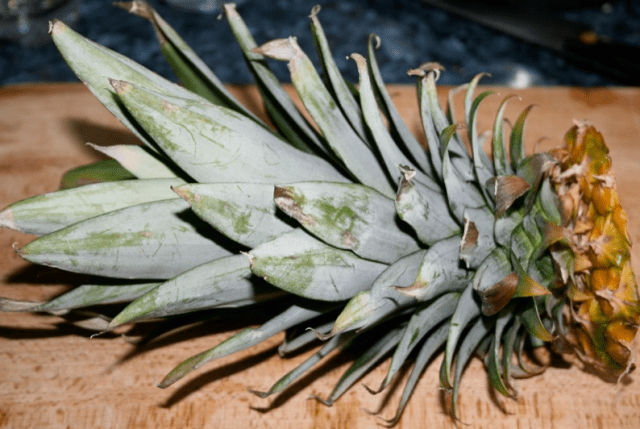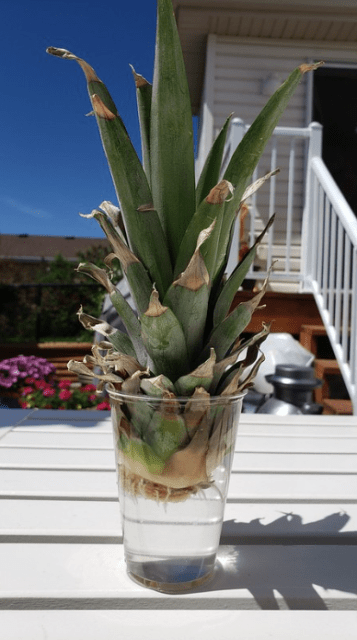Pineapple is quite famous for its sweet and tangy taste. Its shape is also unique, and no other fruit resembles the pineapple. The delicious fruit is packed with vitamins and minerals essential for your body. It will help to fight inflammation, reduce joint pain, and improve digestion.
Pineapples are usually grown in sunny regions of Hawaii, the Philippines, and many more places. But the best thing is that you can grow this fruit in your garden and from store-bought pineapple.
The article discusses about “how to regrow pineapple tops“. So, keep scrolling through this article to learn how to grow a pineapple tree easily in your garden.
How To Grow A Pineapple Top In Water?
Growing a pineapple tree in your house is quite a fun project. You can easily grow them in your garden as they require less maintenance. However, you must first grow indoors and then transplant outside for proper growth.
Below are a few steps you need to follow to grow a pineapple top in water and transplant it to the soil for proper growth.
1. Pick A Fresh Pineapple
Your first duty is to choose a fresh pineapple from the store—the pineapple must have completely fresh green leaves. Don’t choose a pine apple whose leaves have become yellow or brown.
Additionally, you need to smell the fruit. The pineapple chosen for planting should be ripe and have a sweet smell.
But don’t choose an overripe pineapple. These pineapples often have wrinkled skin and can be readily crushed.
You can check pineapple by its leaves. Tug the leaves gently, and if it comes right away, you will understand that the pineapple is too ripe and unsuitable for planting.
Ensure that the pineapple you choose should not have any scale insects in the leaves base.

2. Bend The Pineapple Leaves From The Top
Hold the body of the pineapple in one hand and bend the pineapple leaves from the top in another hand. So, you are left with a crown and fruit.
If you find difficulty in twisting the pineapple leaves, then take a knife and slice the top of the pineapple so that you are left with a crown and fruit.
3. Expose Stem
You need to remove a few bottom leaves from the pineapple crown so that the Stem is completely exposed and can develop roots during planting. If you notice any fruit attached to the pineapple stem, carefully remove it with a knife.
4. Allow The Crown To Dry Completely
The pineapple crown is wet at this stage, and if you plant it, it may rot, and you will fail to grow a pineapple tree. So allow the crown to dry for at least one week. You can keep the pineapple stem upside down in your kitchen and allow it to dry.
Once the crown is completely dry, you can plant it directly in the soil or allow the roots to grow from the crown by planting first in water and then transplanting it to the soil.

5. Sumberge The Pineapple Stem In Water
Take a glass and fill it with water. The glass should be large enough to hold much water because pineapples require more water to develop healthy roots.
The mouth should also be large to place the pineapple stem inside the glass easily. But remember that the pineapple stem should not be completely immersed in water.
6. Stick Two Toothpicks In The Pineapple Stem
The bottom of the pineapple should always be in touch with water to develop healthy roots. So, to ensure it, you can place four toothpicks on the top of the Stem.
The rest of the toothpicks can be placed at the bottom of the Stem, i.e., bear to the glass rim. Now the lower portion of the Stem is immersed in water. The leaves are up and free from water.
7. Place The Glass Jar In Indirect Sunlight
Pineapples grow well in the light. So, now your next duty is to place the glass jar where the crown can receive indirect sunlight for 6-8 hours. You will observe the white roots come from the Stem within 3-6 weeks.
The most favorable temperature for pineapple is between 65 to 85 degrees Fahrenheit. So we recommend not keeping the glass jar in direct sunlight as it will obstruct growth.
Change the water from the glass within three to four days to avoid the growth of bacteria and mold.
8. Fill A Pot With Soil
You need to transplant the pineapple crown once you observe healthy white roots developing from the Stem. Remember, the roots must be at least 3 inches while transplanting.
Take a 6-8 inches pot and fill it with well-drained soil. The pot must have drainage holes to drain out excess water.
9. Time To Transplant
You need to transplant the crown now into the pot. So, once you observe 3 inches of white root developing from the stem, it’s time to transplant.
Make a hole in the soil and insert the crown inside it. Ensure that the lower leaf should be above the soil.
Now press the soil near the Stem and water it properly so it will grow better. You can keep the pot in indirect sunlight for 2-3 weeks.
10. Keep The Pot In Bright Light
The pineapple plant grows well in a warm and sunny environment. Move the plant to a place where the pineapple will receive bright light for at least 6 hours.
If you stay in a warm climate, keep the pot outside and allow the plant to grow. But when the temperature becomes less than 15 degrees Celsius, bring the pot inside.
11. Fertilize Your Plant
Fertilizer is quite essential for the growth of the plant. You can apply fertilizer at least twice a month in every summer season.
But in the winter season, you can apply once a month. Pineapple plants usually require Nitrogen, phosphorous, and potassium in the ratio of 10:10:10.
12. Wait For Flowers To Bloom
You must be patient as it will take almost three years to bloom flowers and bear fruit. You need to continue watering and applying fertilizer within these years.
A red cone will first appear from the center of the leaves and later develop into a blue-colored flower. The flower will later develop into juicy and delicious pineapple fruit. It usually takes six months to grow from flower to fruit.

13. Harvesting
You need to harvest a pineapple when it is ripe and mature. A ripe pineapple will appear one-third yellow, and the rest of the skin will appear bright brown color. Allow the pineapple to ripe because it will not be ripe after plucking. For instance, if you harvest green pineapple, it will not be ripe or become sweeter indoors.
You can harvest a pineapple fruit by cutting it from the base where it joins the Stem.
14. Storing
You can enjoy the pineapple immediately after plucking. However, after dehydrating it, you can store it in an air-tight container and keep it for almost four weeks.
You can keep the pineapples in a freezer and store them for 6-9 months.
Tips To Remember While Growing Pineapple Plant
1. If the pineapple plant is grown in a too-hot or too-cold climate, it will take several years to bear fruit.
2. Moisture is quite crucial for growing pineapple plants. If you overwater them, the roots will rot. Simultaneously, if the pineapple tree does not get enough water, the roots will dry.
3. Full sun is best for the growth of the pineapple plant.
4. Loamy or sandy soil with Ph 4.5 to 5.6 is best for growing the pineapple tree.
5. Some pineapple leaves may damage because of insects. Remove them carefully with shears or a knife. Don’t cut too many leaves, as it will obstruct flower and fruit production.
Common Pests Associated With Pineapple Tree
1. Pineapple mealybug
It is a common pest that is usually seen in pineapple trees. It usually feeds on the green parts of your plant.
They usually cause damage to leaves and roots and may spread the pineapple wilt virus. Neem oil can be used to treat this pest. You can even take a cotton swab dipped with alcohol to release these pests from the leaves.
2.Scale Insect(Diaspis bromeliae)
They mainly feed on the juice of the foliage of your pineapple tree. The Diaspis bromeliae usually look like oysters and attach to the surface of your lant. You can reduce their population by applying insecticidal soap or neem oil.
3. Root -Knot Nematodes
Root-knot nematodes are tiny roundworms that feed on the roots of your pineapple tree. These pests create small nodules on the root and thus prevent the nutrients from going inside the plant.
Diseases Associated With Pineapple Tree
1. Black Rot Disease
Black rot disease usually occurs on a ripened and damaged fruit, mainly at the time of harvesting period.
The parasite Chalara Paradoxa enters into the damaged and ripen fruit and appears in black rot areas on the skin of a pineapple.
2. Pythium And Phytophthora
Pythium and Phytophthora are two fungi that cause root rot in pineapple. You can use fungicides to prevent this fungus. However, well-drained soil is the permanent solution to this problem.
Conclusion
Growing pineapples is an exciting and funny project. These plants can be easily grown indoors. However, if you want fruit from it, transplant the roots in well-drained soil. Keep the pot in a sunny region and water frequently. You will be happy that the pineapple tree will bear fruit within 3-5 years.
Pineapple trees grow best in warm, humid regions. If you live in a colder climate, grow a pineapple tree indoors because freezing temperatures can kill the leaves.
YOU MAY LIKE:
